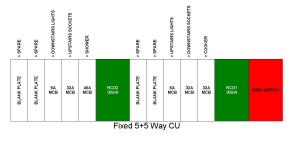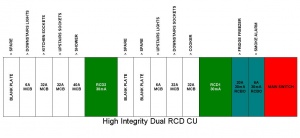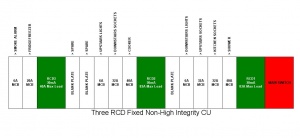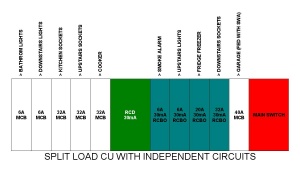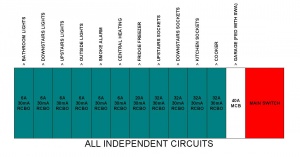17th Edition Consumer Units
Following the 2008 changes to the wiring regulations most circuits are now required to be RCD protected and a new type of Consumer unit has become popular for use in domestic properties.
This is commonly called a 17th Edition Consumer Unit. There are various options available to meet the 17th edition that vary from the "just meets the minimum requirements" to "top of the range" units.
What Is Required by the 17th Edition
RCD protection is now required for
- All sockets up to 20A for general use by ordinary persons (reg 411.3.3) eg general house sockets, garage sockets and cookers with a socket outlet
- All circuits in a bathroom (reg 701.411.3.3) eg lights, shaverpoint, electric showers
- All circuits buried in a wall at less than 50mm and without mechanical protection.(reg 522.6.6) eg most cables in a normal home
It is not permitted to have a single 30mA RCD protecting all the circuits and so usually the use of two or more RCDs are required.
Different Setups
The different setups are explained below
Flexible or Fixed Consumer Units
Many of the CUs mentioned below can be bought as either fixed or flexible (sometimes called configurable). A fixed CU does not allow the installer to alter the number of ways served (or not served) by the RCDs.
Dual RCD
This is the basic 17th edition CU. Typical examples are usually fixed 5+5 and 6+6 way split CUs and there is no provision for non RCD positions. These consumer units are best suited to small properties that have no power to external buildings and only a few circuits. It is usual practice to do a mix with the lighting and socket circuits so that in the event of a fault then some lights and some sockets will stay on (eg upstairs lights and downstairs sockets on one RCD with downstairs lights and upstairs sockets on the other RCD) One limitation of this type of CU is that if mains powered smoke alarms are installed then the regs cannot be met if there are socket circuits on both RCDs as smokes should not share an RCD with sockets.
High Integrity
A high integrity CU is a dual (or more) RCD CU with some independent ways. This allows RCBOs to be used for specific circuits such as smoke alarms or MCBs if allowed. A flexible unit offers the installer more choice over the number of independent ways.
Triple and more RCD
CUs with 3 or more RCDs are now available. Again, they can be fixed or flexible an may be high integrity. Triple RCD CUs commonly have one of the RCDs with a lower maximum load rating than the other two RCDs.
Split Load/One RCD with RCBOs
A split load CU with one RCD and a number of independent ways. The independent ways can be used with RCBOs or MCBs (if allowed)
All RCBOs/All Independent Ways
A CU with all the circuits having individual ways. Usually all the ways will need to be used with RCBOs however MCBs may be used if allowed. This is an expensive option but offers the best discrimination in the event of a fault.
Multiple Consumer Units
Sometimes it is more convenient to use multiple CUs rather than a CU with multiple splits. Multiple CUs can work well when the mounting space available would preclude fitting a single CU large enough to support the number of required circuits. Placing all outdoor circuits in their "own" CU can help prevent any problems with the exterior wiring from affecting the house circuits and causing nuisance trips. With multiple CUs one can make use of simple "switch only" CUs, but with a RCD in the place of the switch, and yet still retain discrimination between the various circuits.
TT Supplies
TT Installations historically used split load CUs with the main incomer switch replaced with a 100mA trip RCD that incorporated a delayed action. Circuits which would have traditionally not had RCD protection (lighting circuits etc) would be on the main RCD side, while socket circuits etc. would be placed on the split side protected by a 30mA trip RCD. This was since one could not rely on the circuit MCBs to disconnect in the event of an earth fault due to the high earth loop resistance.
Under the current rules, the chances are most if not all circuits will need RCD protection at 30mA. Hence most 17th Edition style insulated CUs can be used on a TT system without further change or modification. A high integrity type can be used, but with the incomer switch replaced with a 100mA trip time delay RCD. All RCBO installations are also acceptable.
Circuits that are not RCD Protected
Some circuits such as fridge freezer supplies, central heating may be better without RCD protection. This can only be done if.........(later)
